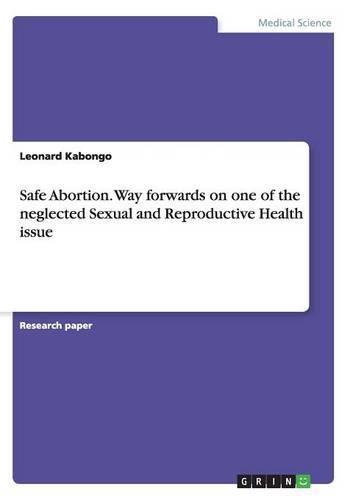Readings Newsletter
Become a Readings Member to make your shopping experience even easier.
Sign in or sign up for free!
You’re not far away from qualifying for FREE standard shipping within Australia
You’ve qualified for FREE standard shipping within Australia
The cart is loading…






Research Paper (undergraduate) from the year 2015 in the subject Medicine - Gynecology, Andrology, grade: A, University of Manchester (HCRI), course: Global Health, language: English, abstract: The World Health Organization defines unsafe abortion as a procedure for terminating a pregnancy that is performed by an individual lacking the necessary skills, or in an environment that does not conform to minimal medical standards, or both. Unsafe abortion is common in places where abortion is illegal. Every year almost 44,000 abortions occur globally and nearly half of them are unsafe whereby almost all unsafe abortions (98 percent) are happening in developing Countries. In Countries where abortion remains unsafe, it is a leading cause of maternal mortality. According to the WHO unsafe abortions contribute to 13% of all maternal mortality globally and are direct cause of maternal mortality in Sub-Saharan Africa. When comparing women with their counterpart men in Sexual and Reproductive Health, there is no such a high cause of mortality in men. This difference shows the existent gender inequality in most developing Countries. In these settings women are denied access to information, education on safe sex, contraception and are not offered an informed consent on their fertility choices. Gender based violence is one of the contributing factor to this inequality that women suffer and this affect their potential development and enjoyment of their right to health including their right to Sexual and Reproductive Health. These universal rights legitimate women to choose whether to conceive or when to form a family. This should have not been difficult to achieve in a World with so much technologies of modern effective contraceptive methods. And the issue of unsafe abortion and its complications could be averted. Conversely this is not the case in the context where legal structures should determine the fate of those who should make decisions for their own lives. The legalization
$9.00 standard shipping within Australia
FREE standard shipping within Australia for orders over $100.00
Express & International shipping calculated at checkout
Research Paper (undergraduate) from the year 2015 in the subject Medicine - Gynecology, Andrology, grade: A, University of Manchester (HCRI), course: Global Health, language: English, abstract: The World Health Organization defines unsafe abortion as a procedure for terminating a pregnancy that is performed by an individual lacking the necessary skills, or in an environment that does not conform to minimal medical standards, or both. Unsafe abortion is common in places where abortion is illegal. Every year almost 44,000 abortions occur globally and nearly half of them are unsafe whereby almost all unsafe abortions (98 percent) are happening in developing Countries. In Countries where abortion remains unsafe, it is a leading cause of maternal mortality. According to the WHO unsafe abortions contribute to 13% of all maternal mortality globally and are direct cause of maternal mortality in Sub-Saharan Africa. When comparing women with their counterpart men in Sexual and Reproductive Health, there is no such a high cause of mortality in men. This difference shows the existent gender inequality in most developing Countries. In these settings women are denied access to information, education on safe sex, contraception and are not offered an informed consent on their fertility choices. Gender based violence is one of the contributing factor to this inequality that women suffer and this affect their potential development and enjoyment of their right to health including their right to Sexual and Reproductive Health. These universal rights legitimate women to choose whether to conceive or when to form a family. This should have not been difficult to achieve in a World with so much technologies of modern effective contraceptive methods. And the issue of unsafe abortion and its complications could be averted. Conversely this is not the case in the context where legal structures should determine the fate of those who should make decisions for their own lives. The legalization